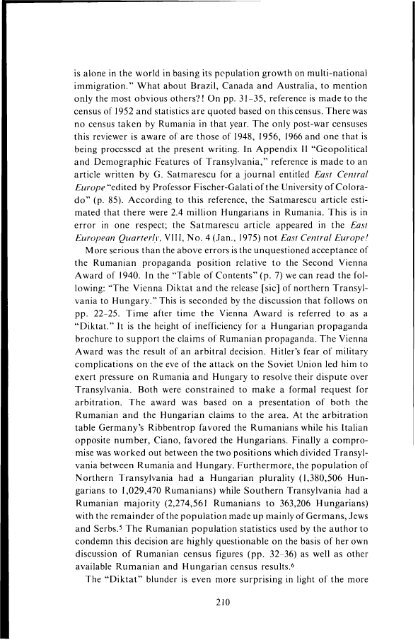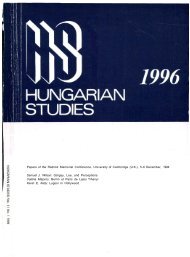is alone in the world in basing its population growth on multi-nationalimmigration." What about Brazil, Canada and Australia, to mentiononly the most obvious others?! On pp. 31 -35, reference is made to thecensus <strong>of</strong> 1952 and statistics are quoted based on this census. <strong>The</strong>re wasno census taken by Rumania in that year. <strong>The</strong> only post-war censusesthis reviewer is aware <strong>of</strong> are those <strong>of</strong> 1948, 1956, 1966 and one that isbeing processed at the present writing. In Appendix II "Geopoliticaland Demographic Features <strong>of</strong> Transylvania," reference is made to anarticle written by G. Satmarescu for a journal entitled East CentralEurope "edited by Pr<strong>of</strong>essor Fischer-Galati <strong>of</strong> the University <strong>of</strong> Colorado"(p. 85). According to this reference, the Satmarescu article estimatedthat there were 2.4 million <strong>Hungarian</strong>s in Rumania. This is inerror in one respect; the Satmarescu article appeared in the EastEuropean Quarterly, VIII, No. 4 (Jan., 1975) not East Central Europe!More serious than the above errors is the unquestioned acceptance <strong>of</strong>the Rumanian propaganda position relative to the Second ViennaAward <strong>of</strong> 1940. In the "Table <strong>of</strong> Contents" (p. 7) we can read the following:"<strong>The</strong> Vienna Diktat and the release [sic] <strong>of</strong> northern Transylvaniato Hungary." This is seconded by the discussion that follows onpp. 22-25. Time after time the Vienna Award is referred to as a"Diktat." It is the height <strong>of</strong> inefficiency for a <strong>Hungarian</strong> propagandabrochure to support the claims <strong>of</strong> Rumanian propaganda. <strong>The</strong> ViennaAward was the result <strong>of</strong> an arbitral decision. Hitler's fear <strong>of</strong> militarycomplications on the eve <strong>of</strong> the attack on the Soviet Union led him toexert pressure on Rumania and Hungary to resolve their dispute overTransylvania. Both were constrained to make a formal request forarbitration. <strong>The</strong> award was based on a presentation <strong>of</strong> both theRumanian and the <strong>Hungarian</strong> claims to the area. At the arbitrationtable Germany's Ribbentrop favored the Rumanians while his Italianopposite number, Ciano, favored the <strong>Hungarian</strong>s. Finally a compromisewas worked out between the two positions which divided Transylvaniabetween Rumania and Hungary. Furthermore, the population <strong>of</strong>Northern Transylvania had a <strong>Hungarian</strong> plurality (1,380,506 <strong>Hungarian</strong>sto 1,029,470 Rumanians) while Southern Transylvania had aRumanian majority (2,274,561 Rumanians to 363,206 <strong>Hungarian</strong>s)with the remainder <strong>of</strong> the population made up mainly <strong>of</strong> Germans, Jewsand Serbs. 5 <strong>The</strong> Rumanian population statistics used by the author tocondemn this decision are highly questionable on the basis <strong>of</strong> her owndiscussion <strong>of</strong> Rumanian census figures (pp. 32-36) as well as otheravailable Rumanian and <strong>Hungarian</strong> census results. 6<strong>The</strong> "Diktat" blunder is even more surprising in light <strong>of</strong> the more
alanced presentation <strong>of</strong> the Vienna Award provided in Appendix I,"An Historical Background," (p. 83). It is hard to imagine that theauthor <strong>of</strong> the brochure was unfamiliar with the contents <strong>of</strong> Appendix I.At the same time, this Appendix (pp. 79-84) is the best written and mosteffectively presented part <strong>of</strong> the entire booklet. Unfortunately there isno indication from where these pages have been obtained. <strong>The</strong> analysis<strong>of</strong> the content, however, convinces this reviewer <strong>of</strong> two things: One, thatthe author <strong>of</strong> this Appendix was not the same person as the author <strong>of</strong>the entire brochure. Two, that the Appendix is taken from a more datedsource. Since no mention is made in it <strong>of</strong> the most recent RumanianConstitution (1967), but the 1952 document is specifically cited (p. 84),we can surmise that it was written sometime in the late 1950's or earlyI960's, — too long ago to be the work <strong>of</strong> the brochure's young author.Aside from Appendix I, the Bibliography (pp. 75-77) deserves somepraise. It includes many <strong>of</strong> the English-language sources that relate tothe fate <strong>of</strong> contemporary Transylvania and the destiny <strong>of</strong> East CentralEurope. It could have been a little more selective, but for the purpose <strong>of</strong>the booklet in question, it is more than adequate. In retrospect, the textdoes not reflect an adequate awareness <strong>of</strong> the wealth <strong>of</strong> informationlisted in the bibliography. <strong>The</strong> extensive footnoting notwithstanding(pp. 59-74), the brochure remains a research paper that has been hastilyprepared for publication. <strong>The</strong> footnotes indicate merely that a greatdeal <strong>of</strong> effort has been exerted to compile the information. However, itis not effective documentation. Some <strong>of</strong> the explanatory footnotesreflect the same unclarity as the text. One example is footnote #17,which states: "Xenophobia, like patriotism, enters into nationalism butis not a part <strong>of</strong> its doctrinal composition." Footnote #23, on the otherhand, must have been left out when the brochure was rushed to theprinter. I seriously doubt that anyone in Astor, Florida read more thanthe title <strong>of</strong> Transylvania: <strong>The</strong> <strong>Hungarian</strong> Minority in Rumania, eitherbefore or after it left the printer. This is irresponsible, and it is unfair,not just to the readers interested in Transylvania, but also to the youngauthor whose name is linked to the brochure.Aside from shoddy workmanship, both <strong>of</strong> the booklets reviewed areobjectionable for one other, more weighty, reason. <strong>The</strong> appearance <strong>of</strong>these booklets will not draw Rumaniansand <strong>Hungarian</strong>s to understandeach other any better. No serious effort is made in either instance topresent an objective analysis. Thus, old myths and illusions are reinforced,thereby projecting into the future the nationality hatreds <strong>of</strong> therecent past. An effort at an objective evaluation — which would alsohave demonstrated the many shortcomings <strong>of</strong> present-day Rumanian
- Page 1 and 2:
Canadian-American Review of Hungari
- Page 3 and 4:
Canadian-American Review of Hungari
- Page 5 and 6:
Canadian-American Review of Hungari
- Page 7 and 8:
Canadian-American Review of Hungari
- Page 9 and 10:
the best possible settlers who woul
- Page 11 and 12:
than a decade later they were follo
- Page 13 and 14:
Sociologists have yet to explain sa
- Page 15:
fifteen minutes, and spent the rest
- Page 18 and 19:
from the "Canadian poetry" of Icela
- Page 20 and 21:
garian community of Western Canada,
- Page 22 and 23:
lowed translations from other, more
- Page 24 and 25:
which took place in the pages of th
- Page 27 and 28:
from teaching in 1968, Kirkconnell
- Page 29 and 30:
Magyar poets and writers to the rea
- Page 31 and 32:
tive of his helpful attitude and un
- Page 33:
33. Kirkconnell, A Slice of Canada,
- Page 36 and 37:
The groaning of the slaves on Egypt
- Page 38 and 39:
ecause most such lines are imbedded
- Page 40 and 41:
;Two spheres contend with one anoth
- Page 42 and 43:
matched it to this feeble hurdy-gur
- Page 44 and 45:
NOTES1. The only full-length study
- Page 46 and 47:
terest in Hungarian literature, has
- Page 48 and 49:
limitations of Bowring and others:
- Page 50 and 51: Jones' Five Hungarian WritersJ 4 Su
- Page 53 and 54: REVIEW ARTICLEHungarian Poetry in E
- Page 55 and 56: ooks written in English. A table of
- Page 57 and 58: passive, or into noun phrases in En
- Page 59 and 60: REVIEW ARTICLEHungarian Religious P
- Page 61 and 62: magas és a mély magánhangzójú
- Page 63 and 64: SPECIAL SECTIONToldiAn Epic Poem (1
- Page 65 and 66: CANTO ONE"He lifted, with one hand,
- Page 67 and 68: "Who should be squire of this whole
- Page 69 and 70: What meant this hubbub in a widow's
- Page 71 and 72: "Lad, here's your share! Don't say
- Page 73 and 74: The heavy stone flies on: where wil
- Page 75 and 76: The homes of moorhen, plover, gull
- Page 77 and 78: Perhaps I'll shed my blood, some no
- Page 79 and 80: CANTO FIVENicholas went wandering a
- Page 81 and 82: Her tongue was like a coulter in th
- Page 83 and 84: Rosemary pots mourned on its window
- Page 85 and 86: Such were her words. No more would
- Page 87 and 88: As if a nest of hornets rose to sti
- Page 89 and 90: Upon an isle, by a Czech's hand the
- Page 95 and 96: REVIEW ARTICLEQuo Vadis Transylvani
- Page 97 and 98: Hungarians in Rumania in terms of t
- Page 99: down by serious shortcomings in bot
- Page 104 and 105: talent enables Wass to depict the s
- Page 106 and 107: Carpathian Federation, and printed
- Page 108 and 109: Now and then, however, this rule de
- Page 110 and 111: temper such an indictment by recogn
- Page 112 and 113: OUR CONTRIBUTORS (continued from pa
- Page 115: TO THOSE WISHING TO SUBMIT MANUSCRI
















